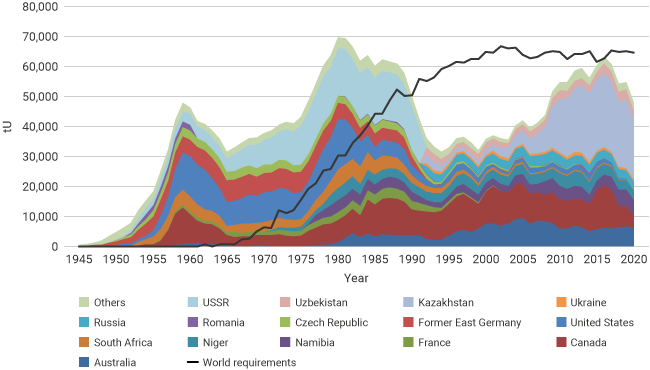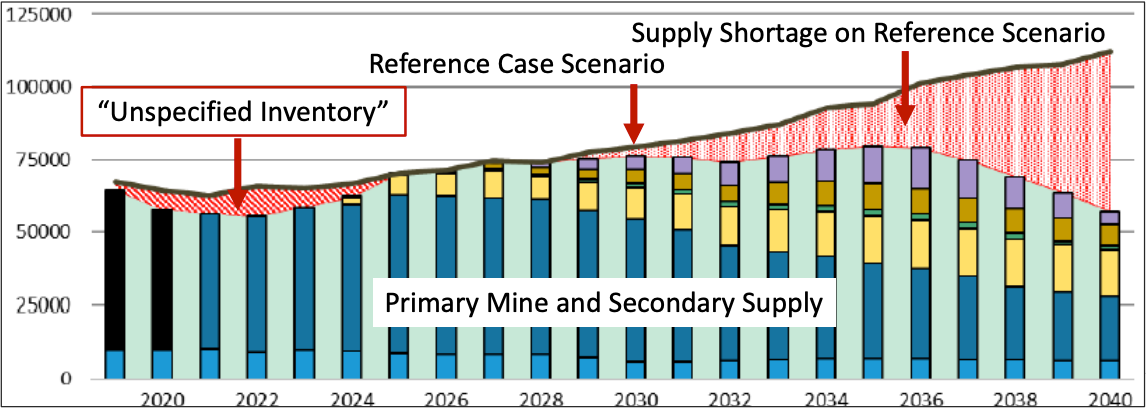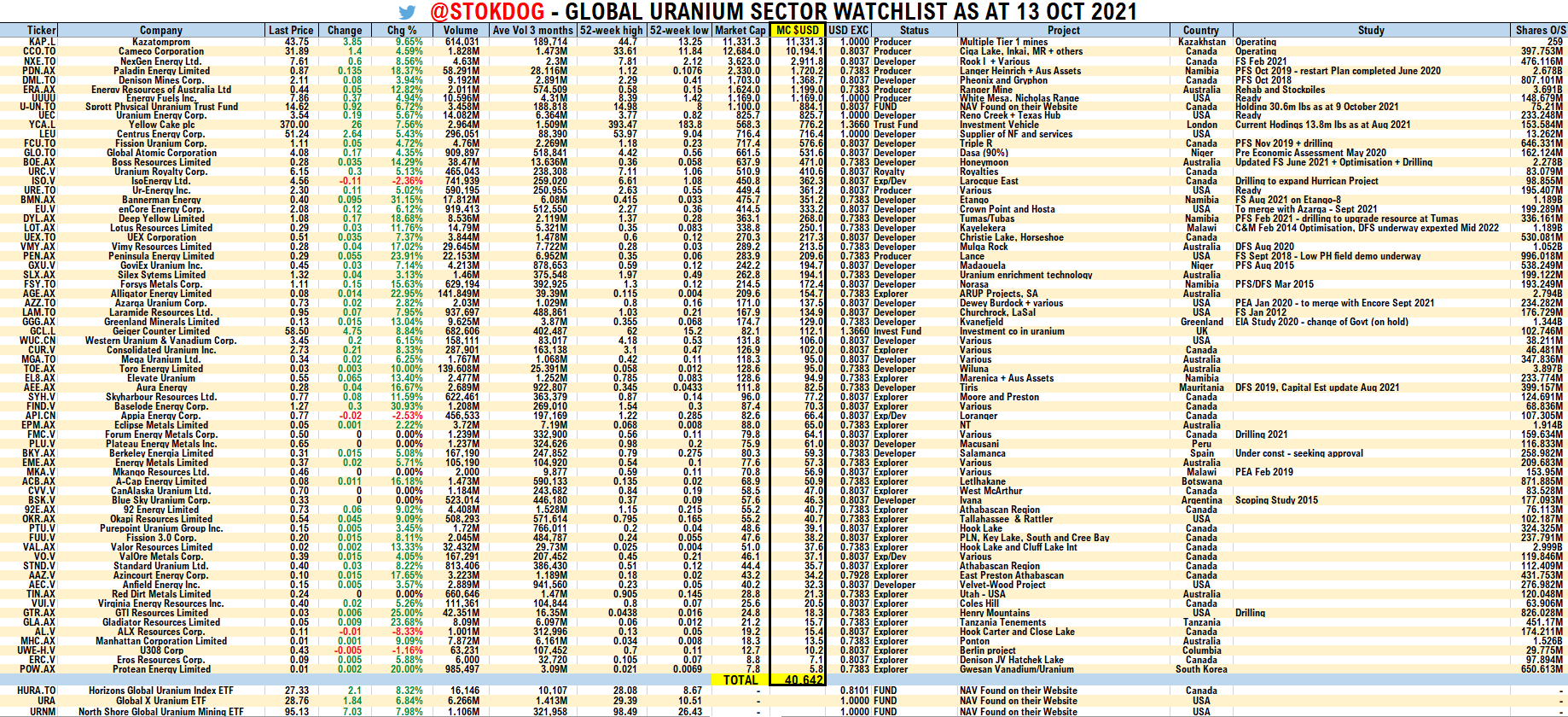Uranium: The bull market everybody’s talking about
Three years ago, uranium was 'The bull market nobody was talking about', as I wrote in my earlier wire. But in 2021, it's finally caught the attention of investors. While the metal itself bottomed in late 2016, for miners and hopefuls the recovery has been a slow and painful one. Until recently.
As recently as November last year, an investor could’ve (theoretically) bought all the shares in every listed uranium company in the world for under US$12 billion. That’s approximately the market capitalisation of Santos today. And this is for an industry that supplies 10% of the world’s electrical power generation.
2021 has seen several important developments in the sector. One of Australia’s largest uranium companies, Paladin Energy (PDN) has returned over 500% in the last year. But despite this, the market cap of the sector today is around US$34 billion. (Ed's Note: in the time it took to complete this article, the combined market cap jumped from $34 billion to $40 billion!)
So, what’s behind these explosive returns? What does the future look like? And how can investors get exposure? I recently spoke with three experts in the uranium industry to get an understanding of these issues.
In this deep dive into the sector, I speak with Brandon Munro, CEO of Bannerman Energy, Leigh Curyer, CEO of NexGen Energy, and Guy Keller, Portfolio Manager of the Tribeca Nuclear Opportunities Fund.
The setup
The beginnings of this story trace all the way back to 2011, when the great Tohoku earthquake hit Japan. Though 18,000 people were tragically killed by the tsunami, it’s the nuclear meltdown at the Fukushima Daiichi Nuclear Power Plant that received the most attention outside Japan.
In the aftermath of the disaster, there was a notable shift in attitudes towards nuclear power, particularly in Japan and Germany, who began to shutdown working reactors.
“Fukushima created a hole in demand of about 10% in this sector. And that was huge, given nuclear power and uranium supply had generally worked hand in hand in relative equilibrium,” said Brandon Munro.
Unlike many industries, uranium mining serves only a single purpose – to power nuclear reactors. So, any drop in demand from utilities would have an outsized effect on the market.
“When that hole occurred, because of shutdowns in Germany and in Japan predominantly, supply continued to roll on because all of the world's uranium suppliers were running off long term contracts. Now that set the stage for several years of oversupply, several years of falling prices, and a very long, deep, difficult bear market for uranium equities,” he said.
And that’s exactly what followed. The uranium price fell from US$71 per pound in February 2011, to a low of $US18 at the end of 2016.
The uranium price bottoms, but equities don’t
Starting in 2017, uranium mining companies began slashing supply. This wasn’t like what was seen in other commodities such as oil and gas, where only the high-cost, marginal production was cut. At $18/lb, no uranium mine in the world was making money. Even the lowest cost suppliers were just breaking even.
In addition to cutting supply at several smaller operations, Cameco, one of the two major producers globally, announced the ‘temporary’ closure of its McArthur River Mine, the world’s largest uranium mine. Less than a month later, Kazatomprom, the other major producer, announced it would slash production by over 24 million pounds. The two announcements alone removed 17.5% of global supply. Saudi Arabia currently produces 17% of global oil supplies.
“Kazatomprom initially cut their supply by 10%, and then by 20%. And that supply discipline has in fact, continued to this day, and they've told the London Stock Exchange that they would continue out through 2023,” Munro told us.
While the price never again reached its lows of $18/lb, the recovery was far slower than anyone expected at the time. And with most projects requiring prices above US$50/lb before they could even consider restarting, uranium juniors were left languishing in the dark.
“There were too many pounds available. There was no sense of concern on the part of utilities because they could get the pounds they wanted. They could also get them very cheaply. The price dropped as low as $18 a pound, which was well below most of the world's cost of production, let alone profitable level of production. And it took us a long time of running deficits to work off the inventory that the utilities had built up over that period as they continued to take delivery of those long-term contracts signed before Fukushima.”
All these shutdowns did have an effect on supply, but the price response was far from immediate. The problem was that nuclear utilities had been taking delivery on existing long-term supply contracts this whole time, but those inventories had just been piling up as the market was oversupplied.
“Utilities drew down those inventories. And so that's why even with a substantial deficit, we didn't see any serious pressure on price. And so this unsustainably low pricing situation continued. As recently as March this year the spot price was below $30,” he said.
Arguably, this price imbalance still exists today. While Cameco and Kazatomprom are making money with prices between US$40 and $50/lb, new supply is required to bring the market back into balance. The ‘incentive price’ – the price at which new supply might start to be brought online – is estimated to be in the range of US$60-70/lb.
Uranium supply and demand - historical

The bull begins to charge
Like many industries, uranium mining was heavily affected by COVID. Between April and August 2020, Kazatomprom reduced staffing levels, impacting production in the second half. But still, the bull remained dormant.
In late March, Cameco announced the temporary suspension of Cigar Lake, the world's largest uranium mine. Initially this was just for four weeks. Come April however, the mine was placed on care and maintenance for an "indeterminate period" .
The mine was restarted in September, but it didn't last long.
In late November, Cameco announced a positive COVID case at Cigar Lake. And then some more. Two weeks later, Cigar Lake was closed again. And it stayed closed until April 2021.
“(COVID) caused the two largest tier one producers of uranium to cut supply, which set a cat amongst the pigeons, and we saw the spot price move from mid 20s to $34, before running out a little bit of steam,” Guy Keller said.
According to Munro though, it was not the closure of Cigar Lake itself that caused the market to sit up and pay attention. Instead it was a massive inflow of funds into the relatively tiny sector from professional investors who locked onto the thesis in anticipation of financial investors accumulating physical uranium. Munro postulates the precise trigger might be a newsletter called The Bear Traps Report, which was subsequently circulated by the well known Zerohedge website.
Uranium equities took off. Paladin (PDN) was trading under 12c at the beginning of November. By mid-January, it had risen to a high of nearly 35c!
SPUT lights a fire under the uranium market
In April, Sprott Asset Management completely changed the market.
Sprott already ran several physical commodities trusts covering gold, silver, platinum, and palladium. But the announcement of their takeover of Uranium Participation Corp (since rebranded as Sprott Physical Uranium Trust – SPUT) was significant for several reasons.
While the old UPC held a static amount of uranium, SPUT would take a very different approach. The ‘At The Market’ (ATM) facility allowed Sprott to issue new units in the trust whenever the trust traded at a premium to its net asset value. This additional cash could then be used to buy more uranium.
At the end of May, UPC held 19.3 million pounds of uranium. In less than three months since the official launch of SPUT, that figure has expanded to over 31 million pounds. That additional 11.7 million pounds is over 8% of global annual mine supply. If the current pace were to continue for a year, SPUT would end up buying one third of the world’s mine supply.
This is in a market that is already undersupplied by 50 million pounds per annum.
Uranium supply and demand - projected

(note: y axis is tonnes of uranium)
And it’s not just SPUT getting in on the action. Uranium development companies such as Boss Energy (BOE) and Peninsula Energy (PEN) began raising capital to purchase pounds of uranium for storage. This took millions of pounds of supply out of the market. Boss’ purchase alone accounted for nearly 1% of global annual mine supply.
Eventually, the price of uranium began to move. From US$28/lb in March, the price rose above US$50/lb in September. A big move, but still well below the incentive price to bring new supply online.
The future of nuclear
Before considering potential future demand increases, it’s important to note that they are not essential to the bull thesis. When asked directly whether “additional reactors, restarts, life extensions, etc are required for the uranium bull thesis to play out,” Leigh Curyer responded with an emphatic “no”.
“In 2019, there was a new record for the amount of nuclear power generation for a given calendar year. So my answer is no, nuclear demand is pretty well understood and certainly not going down. While the demand curve had those reactors in the US closing down over this decade, a lot of the supportive policy changes that have occurred recently indicate they now need to be inserted back into the demand forecast. The outlook is very, very strong,” Curyer said.
As referenced above, governments around the world are increasingly realising the importance of reliable, carbon-free power generation.
In the state of Illinois, it was announced just last month that four reactors scheduled for shutdown this year have had their lives extended by at least five years. US Energy Secretary Jennifer Graham recently stated that “Nuclear energy is essential to confronting the crisis of our lifetime: climate change”. Curyer said that these developments are “probably the most significant on the demand side,” saying that the significance is “enormous.”
France, which survived the Hollande-era policy of shutting down reactors over the last decade, currently boasts some of the cheapest, most reliable, and cleanest electricity in Europe. 70% of their power comes from nuclear. French President Emmanuel Macron recently announced a 1 billion Euro investment into developing Small Modular Reactors for hydrogen production and export.
Meanwhile the unfolding energy crisis in Europe has forced politicians, policy makers and citizens to acknowledge the inescapable logic of nuclear power. Attributes such as 24/7 reliability, resilience in all climatic conditions, stable pricing and superior energy security have moved new nuclear builds back onto the agenda. New nuclear programs in France, United States, United Kingdom, Russia and China all point to a revival in nuclear power that will stress current and potential uranium supply.
According to Munro, who is co-chair of the World Nuclear Association’s Nuclear Fuel Demand Working Group, “we are on the cusp of a new nuclear age in which decarbonisation imperatives collide head-on with unrealistic expectations of renewables penetration, leaving nuclear power to wean the world off coal and decarbonise the expanding electrical grid, domestic heating, industrial heating and hard to abate areas of industry including hydrogen production. If nuclear power can achieve its decarbonisation potential around the world, the implications for uranium demand will be astonishing.”
Japan, where this whole story started, recently got a new Prime Minister. Prime Minister Fumio Kishida has stated that “it’s crucial that we re-start nuclear power plants”. Japan has been incredibly slow to restart its reactors thus far, but new leadership has sparked hope among nuclear proponents.
“(The reactor restarts) have been slower than anyone expected. There's eight currently in operation. And I think another 24 operable but currently not in operation. It was only a few weeks ago that both sides of the Japanese Parliament said ‘we've got to get these nuclear reactors up and running just for an energy need, let alone clean air energy need.’ And they are a 100% importer of energy fuel into their country. It's very positive for nuclear, and both sides of the Japanese parliament are in favour and supportive of it, so that could start to accelerate,” Curyer commented.
China has been one of the main sources of nuclear capacity expansion in recent years. In 2010, nuclear energy accounted for just 2% of its overall electricity generation. In 2020, that number was just shy of 5%. China currently has 50 operational reactors, 16 under construction, and 45 in planning.
How to get exposure
For investors looking for straightforward exposure to the uranium price, they’ll need to look overseas to Canada or London.
“There's been a huge amount of interest around the Sprott vehicle, the Sprott Physical Uranium Trust. There's also London listed Yellow Cake. We were a substantial shareholder in Yellow Cake when it IPO’d a few years ago. So that gives you proxy exposure to the uranium price,” Keller said.
The Sprott trust currently trades on the Toronto Stock Exchange under the tickers U-UN (Canadian Dollars) and U-U (US Dollars). Sprott also plan to list the vehicle on the New York Stock Exchange in the near future. In London, Yellow Cake PLC trade under the ticker YCA.
Both the Sprott vehicle and Yellow Cake hold and store physical uranium and derive their net asset value from the value of that uranium. Both can trade at a discount or a premium to net asset value, just like an LIC or an LIT on the ASX.
For ASX investors, there are plenty of choices, though none are currently producing uranium. The largest players are Paladin Energy, Boss Energy, Bannerman Energy, Deep Yellow, and Lotus Resources. Paladin, Boss, and Lotus all boast existing infrastructure at mines that have previous produced uranium, while Bannerman and Deep Yellow are ‘greenfields’ projects that will require mines and plants to be built.
NexGen Energy recently added an ASX listing under the code NXG. While ASX liquidity is currently limited, NexGen is currently the third largest uranium company globally, and is the largest (by market cap) that trades on the ASX.
Though several uranium ETFs are available overseas, Keller warns that some of the most popular ones are poorly structured, holding companies with minimal exposure to the uranium price.
“The big Global-X ETF… I mean it’s got Macquarie Bank in it because they’ve got one person in London trading physical uranium. If you think the Macquarie Bank uranium trader is doing enough to move that needle, then it’s a great investment,” Keller said sarcastically.
Twitter user @Stokdog has been tracking a huge number of uranium equities and has kindly provided the list below. While it may not include every uranium related company in the world, it certainly covers the vast majority of them. Companies with “.AX” at the end of the ticker code are ASX listed. (Click to enlarge)

The most important considerations about NexGen Energy, according to the CEO
Direct from the mouth of the CEO, this is what Leigh Curyer says prospective uranium investors should consider about NexGen:
“We are developing the world's largest, highest-grade deposit as we speak, we have a highly dedicated team which exhibit experience right through all facets of the mining lifecycle from exploration right through to closure and reclamation. We have demonstrated at every stage of our incorporation from 2011, right through today, there's no company in the sector that has deployed a more efficient use of capital. The ratio of exploration development relative to overhead, leads the sector by a very long margin. We have very high discipline around capital allocation.
So while we have what everyone recognises as the world's best asset, we're taking it upon ourselves to judge ourselves on how we actually optimise that. We're constantly coming into the office every day on how do we optimise, how do we optimise? And that's the dedication that you get with investing in NexGen. It's not just about the asset, it's about the way we go about it.
And I can tell you, it's an absolute privilege to lead such a dedicated, committed team with respect. We know we've got something special, we know our efforts are going to affect a lot of people we probably won't even meet in our lives. And I think you can be the best accountant, lawyer or geologist or many of the disciplines that we have at NexGen, but you've got an opportunity at NexGen to also positively affect a lot of people that you won't even most likely meet. I think that's a very special opportunity and requires people to take it very seriously.”
The most important considerations about Bannerman Energy, according to the CEO
“Bannerman is attractive to investors because it offers exceptional leverage to high price scenarios. With underinvestment in uranium supply, depletion of existing production over the next decade and a feast of demand growth signals, investors are entering the sector because they expect uranium prices to increase. That leverage comes from the sheer scale of our resource and scalable annual production that would intitially fuel 7-8 GW of nuclear capacity and could then double once in production. Crucially for many investors, Bannerman is positioned to produce pounds into this market cycle, with environmental approvals, an advanced asset, an operating jurisdiction where we can get it done and a team that has run uranium mines in Namibia. We've completed a robust Preliminary Feasibility Study on Etango-8 and plan to complete the Definitive Feasibility Study within 12 months. We have a development pathway that puts us in production in 2025.
So, our capacity to convert those high price scenarios into our bank account by mid-decade sets us apart from most uranium companies.
Crucially important is the advantage we have through operating in Namibia. Namibia has a 45-year history of uranium mining and is the third largest producer of uranium in the world today. Namibia has good export infrastructure, stability and security, and a development agenda. The strong government and community support for uranium mining removes a risk factor that has claimed many a uranium scalp.”
Keller’s pick of the bunch
I posed Keller the tough question of which uranium stock he’d own if he could only own one.
“That’s such a hard question… To be on-song with what I was preaching earlier in our chat, I’d have to say Boss, if I was going to say anything. It’s not a huge amount of money for them to come to market. They’re at the right end of the cost curve, they tick a whole bunch of boxes with ESG, being in-situ recovery. Right jurisdiction. So, if I was going to bet on one, that was going to give me some cashflow at some stage, it would be them.
I could be lazy and say you own Cameco because they’ve got a heap of money in the bank, they’re the largest, they’ve got a big asset they can bring back on at the right price – 18 million pounds. But that’s sorta like saying you’re paying fees to the (Tribeca) Global Natural Resources Fund to be long BHP.”
Want to hear more from Curyer, Munro, and Keller?
This article is based on my discussions with the three professionals quoted throughout. Unfortunately, even in a 3000+ word article, there was not enough space to fit everything we discussed. Click on the link below to hear all three interviews in their entirety as special podcast mini-series.

DISCLOSURE: The author owns shares in several of the companies discussed in this article.
Never miss an update
Enjoy this wire? Hit the 'like' button to let us know. Stay up to date with my content by hitting the 'follow' button below and you'll be notified every time I post a wire.
Not already a Livewire member? Sign up today to get free access to investment ideas and strategies from Australia’s leading investors.
1 topic
9 stocks mentioned
1 contributor mentioned



